The rise of technology and automation has profoundly transformed the way organisations operate – there are now boundless opportunities for increased productivity and efficiency. Nowadays, automation presents HR professionals with exciting possibilities for streamlining HR systems and processes and enhancing employee experiences.
✔️ Automating HR processes can help organisations reduce errors, save time, and increase efficiencies. In a recent study, nearly half of employers reported that greater HR automation had decreased their admin tasks.
But with such a variety of HR software available, it can be difficult to discern essential features from nice-to-haves. To help you navigate this fast-paced landscape, we’ve compiled a list of the 6 most popular HR processes you should consider automating. 👇
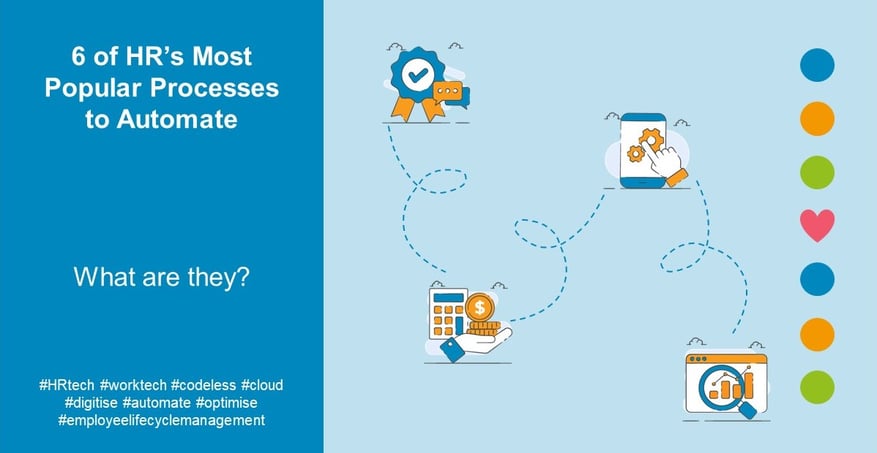
What Is HR Process Automation?
HR automation refers to the process of leveraging technology to optimise HR efficiency. Employees become no longer tied down with time-consuming manual tasks – as a result, they can concentrate on more value-adding activities like decision-making and strategic planning.
The benefits of HR process automation are actually quite impressive:
-
Improved efficiency
-
Increased accuracy
-
Reduced workload
-
Cost savings
-
Less time spent on manual tasks
-
Less potential for human error
There are various HR process automation tools available in the market, with each tool designed to streamline specific HR functions.
➥ Applicant tracking systems (ATS) automate the recruitment process by tracking job applicants, screening resumes, and scheduling interviews.
➥ Onboarding software can simplify the new hire process by automatically sending welcome emails, collecting employee information, and delivering training materials.
➥ Payroll processing software can automate payroll calculations, generate paychecks, and ensure compliance with labour laws and tax regulations.
➥ Performance management software can streamline the process of setting goals, providing feedback, and tracking employee performance.
With these and other HR process automation tools, HR departments can reduce the time and effort required for routine HR tasks and focus on more strategic activities that drive business success.
But what are the HR processes you should think about automating? Let’s explore! 🔍
The 6 HR Process You Should Automate
Recruitment Process Automation
Automation has the power to significantly streamline the recruitment process to save time and increase efficiency. HR teams can leverage a range of recruitment process automation tools to reduce the workload and ensure a smooth hiring process. 👇
Applicant Tracking Systems (ATS)
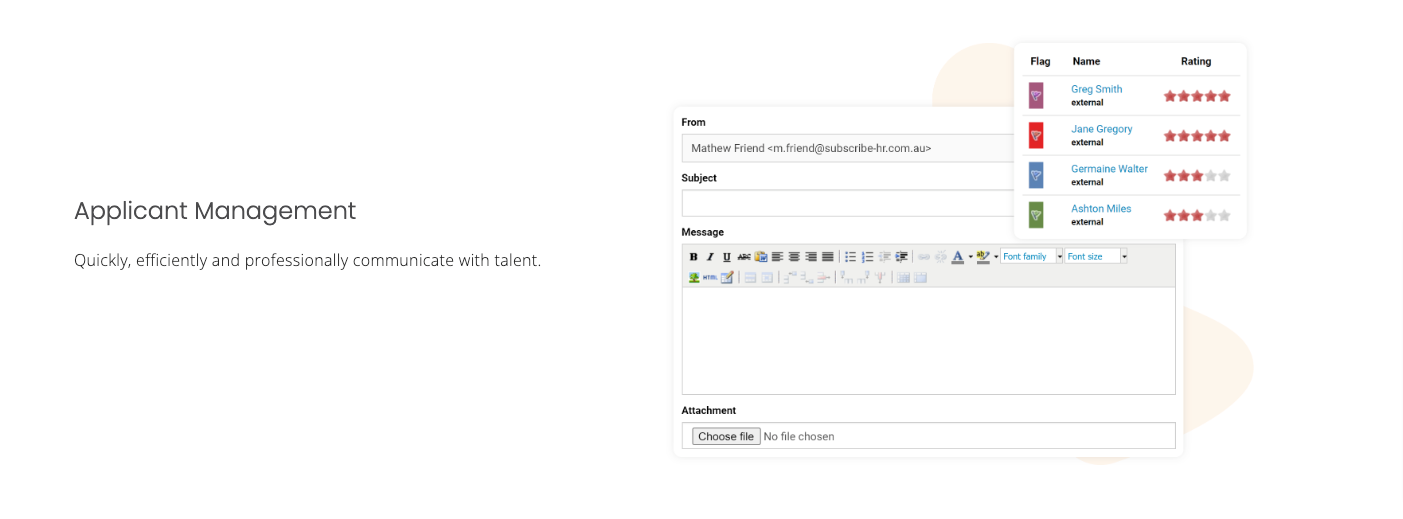
What: Applicant Tracking Systems (ATS)
Why: An ATS system helps automate the hiring process by tracking and organising job applicants, screening resumes, and scheduling interviews. ATS systems can also help HR teams manage compliance issues and provide reporting and analytics.
Job Board Postings
.png?width=619&height=454&name=e-Recruitment%20Software%20_%20Employee%20Onboarding%20Software%20_%20Cloud%20_%20SaaS%20(1).png)
What: Automated job board postings can help HR teams advertise job openings on multiple job sites simultaneously.
Why: To increase the reach and visibility of job postings while reducing the time and effort required for manual posting.
Chatbots
What: Chatbots can automate the early stages of the recruitment process by engaging with job applicants, answering common questions, and providing basic screening.
Why: To reduce the workload for HR teams and improve the candidate experience.
Video Interviewing
What: Video interviewing can help streamline the interview process by enabling HR teams to conduct remote interviews with candidates.
Why: To save time and resources, allowing HR teams to focus on other tasks while ensuring a consistent and efficient interview process.
Background Screening
What: Background screening software can help automate the process of verifying a candidate's employment history, education, and criminal records.
Why: To reduce the workload for HR teams and ensure a thorough and accurate screening process.
AI-Powered Sourcing
What: AI-powered sourcing can help HR teams find and attract top talent by using AI algorithms to search for and evaluate candidate resumes and profiles.
Why: To help HR teams save time and improve the quality of candidate sourcing.
.jpg?width=6016&height=4016&name=christina-wocintechchat-com-vzfgh3RAPzM-unsplash%20(1).jpg)
Onboarding Process Automation
Electronic Forms
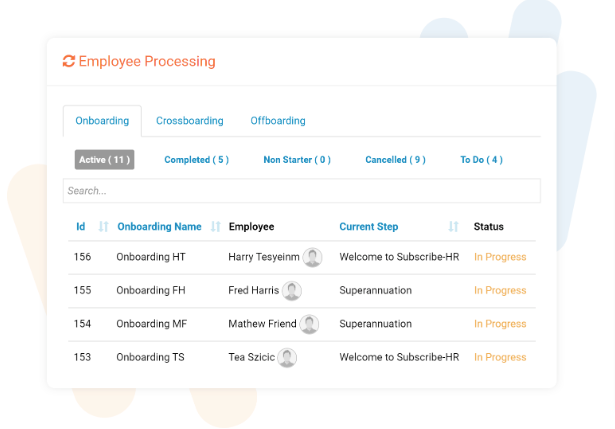
What: Electronic forms can help streamline the paperwork required during the onboarding process. New employees can fill out and sign all necessary forms electronically.
Why: To reduce the time and effort required for manual processing.
Pre-boarding
What: Pre-boarding tools can help new employees get up to speed before their official start date. These tools can include access to training materials, company information, and other resources.
Why: To help new employees prepare for their role.
Task Management
.png?width=661&height=472&name=Employee%20Onboarding%20Software%20_%20Cloud%20HR%20Software%20_%20Cloud%20_%20SaaS%20(1).png)
What: Task management tools can help HR teams assign and track tasks related to the onboarding process.
Why: To ensure that all necessary tasks are completed on time, and nothing falls through the cracks.
Automated Training
What: Automated training tools include e-learning modules, videos, and quizzes, among other resources.
Why: To help new employees complete their training requirements quickly and efficiently.
Managerial Alerts
What: Managerial alerts can help keep managers informed of new employees' progress during the onboarding process. These alerts can be triggered upon completion of specific tasks or milestones
Why: To provide support and feedback to new employees as needed.
Employee Surveys
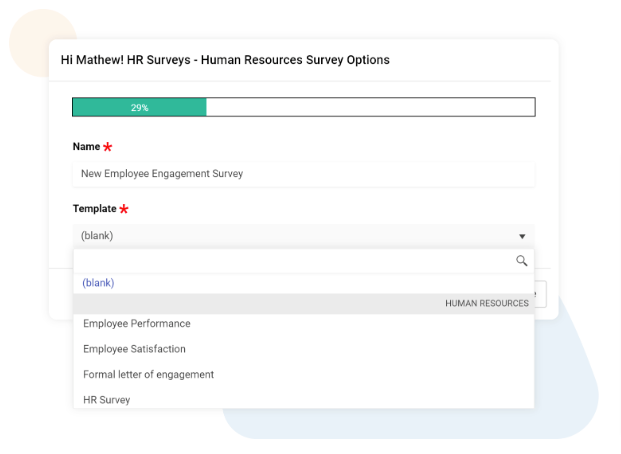
What: Employee surveys can help HR teams gather feedback on the onboarding process and identify areas for improvement. These surveys can be automated and sent out to new employees at specific intervals.
Why: To help HR teams continuously improve the onboarding experience.
Performance Management Process Automation
Performance management is a critical process that enables organisations to monitor, measure, and improve employee performance. HR teams can leverage a range of performance management process automation tools to streamline this process, reduce the workload, and improve the accuracy and effectiveness of performance management.
Goal Setting and Tracking
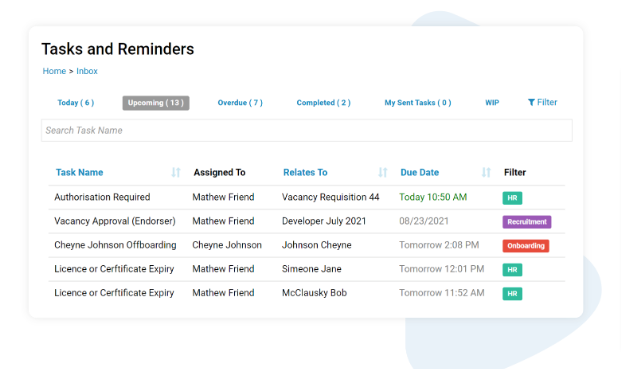
What: Goal setting and tracking tools
Why: To help HR teams set clear and specific performance goals for employees and track progress towards these goals + help increase employee engagement and motivation while improving overall performance.
Continuous Feedback
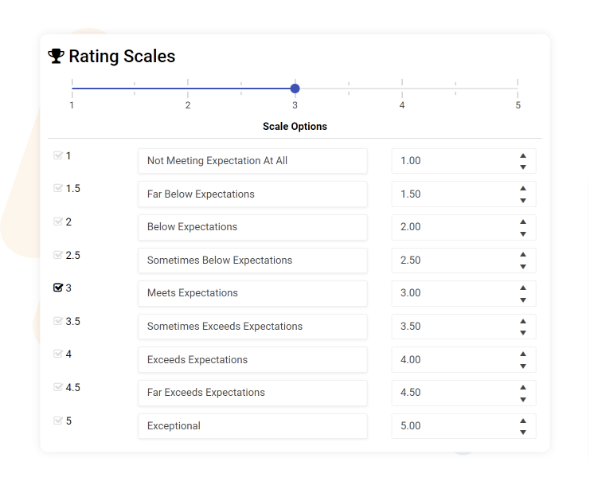
What: Continuous feedback tools can enable managers and employees to provide ongoing feedback on performance.
Why: To help improve communication, build trust, and foster a culture of transparency and accountability.
Performance Metrics
What: Performance metrics tools can help HR teams measure and analyse key performance indicators (KPIs) related to employee performance.
Why: To help identify areas for improvement, benchmark performance against industry standards, and align individual goals with organisational objectives.
Development Planning
What: Development planning tools include training, mentoring, and coaching opportunities to help employees reach their full potential.
Why: To help HR teams create individualised development plans for employees to help them improve their skills and abilities.
Performance Reviews
.png?width=616&height=423&name=Performance%20Management%20Software%20_%20HR%20Cloud%20Software%20_%20SaaS%20(1).png)
What: Performance review tools can help automate the performance review process by providing a centralised platform for managers and employees to complete reviews.
Why: To streamline the review process, ensure consistency, and provide a record of feedback and progress.
Reporting and Analytics
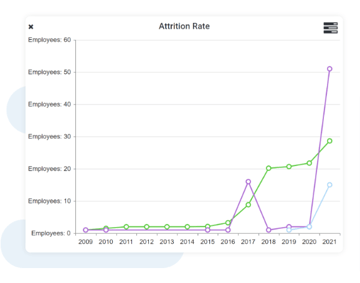
What: Reporting and analytics tools can provide HR teams with valuable insights into performance trends and patterns.
Why: To help identify areas for improvement, track progress, and make data-driven decisions.
Employee Training and Development Automation
Learning Management Systems (LMS)
What: LMS platforms include features such as course authoring, curriculum design, tracking, and reporting.
Why: To help automate the delivery and tracking of employee training programs.
Personalised Learning Paths
What: Personalised learning paths give training content that is tailored to their individual learning needs and preferences.
Why: To increase employee engagement and retention of the material.
Automated Assessments
What: Automated assessments can be integrated into the training program and can include quizzes, tests, and surveys.
Why: To help HR teams evaluate employee learning and knowledge retention.
Virtual Training
What: Virtual training tools include webinars, e-learning modules, and other online training resources.
Why: To provide employees with access to training programs from anywhere and at any time.
Gamification
What: Gamification means adding game-like elements such as leaderboards, points, badges, and challenges.
Why: To help increase employee engagement in training programs.
Performance Support Tools
What: Performance support tools can include job aids, checklists, and other resources that help employees apply new skills and knowledge on the job.
Why: To help employees apply what they've learned in training to their day-to-day work.
Time and Attendance Management Automation
Automated Time Tracking
What: Automated time-tracking tools eliminate the need for manual timekeeping methods. Employees can clock in and out using digital systems, biometric devices, or mobile applications, providing accurate records of their work hours.
Why: To not only reduce errors but also save valuable time spent on manual data entry.
Shift Scheduling
What: Shift scheduling automation tools take into account factors like availability, skills, and business requirements to generate optimised schedules.
Why: To simplify the process of creating employee schedules.
Overtime Calculations
What: Compliance with labour laws and accurate overtime calculations are essential. Automation tools can accurately calculate overtime hours based on predefined rules and regulations.
Why: To ensure accurate compensation for overtime work, reduce the risk of errors, and help maintain legal compliance.
Leave Management
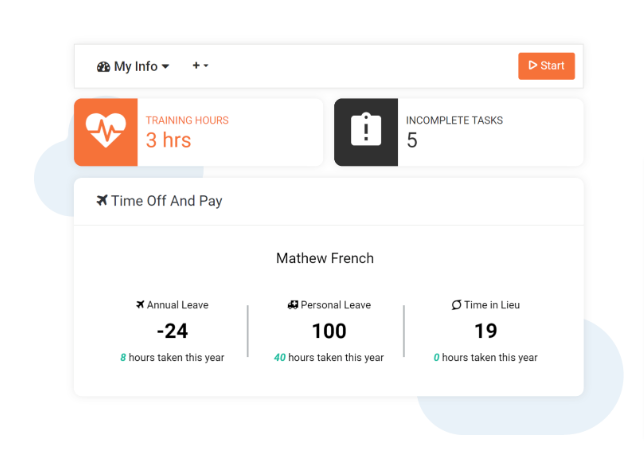
What: Leave management automation simplifies the process of requesting, approving, and tracking employee leaves. Employees can submit leave requests digitally, and managers can review and approve them through the system.
Why: To ensure compliance with company policies, minimises conflicts, and facilitate efficient scheduling.
Time and Attendance Reports
What: Time and attendance automation tools generate comprehensive reports that provide valuable insights into employee attendance patterns, productivity trends, and labour costs.
Why: To help HR and management make data-driven decisions, optimise resource allocation, and identify areas for improvement.
Integration with Payroll
.png?width=638&height=388&name=Payroll%20Software%20_%20HR%20Software%20_%20Cloud%20_%20SaaS%20(1).png)
What: Integration with payroll systems.
Why: To ensure seamless transfer of attendance data for accurate and timely payroll processing.
Payroll and Benefits Administration Automation

Managing payroll and benefits efficiently is crucial for organisations to ensure employees are paid accurately and on time while following legal requirements. Manual processes can be time-consuming, prone to errors, and resource-intensive. However, with the use of automation tools for payroll and benefits administration, organisations can simplify these tasks, improve accuracy, and increase efficiency.
Automated Payroll Processing
What: Automated payroll processing tools simplify the complex task of calculating wages, deductions, and taxes.
Why: To automate the entire payroll process, from data entry to generating paychecks, ensuring accuracy, reducing errors, and saving time.
Benefits Enrollment and Administration
What: Automation tools allow employees to easily select and enrol in benefits programs through self-service portals. HR teams can efficiently manage and update benefits information, such as health insurance, retirement plans, and other employee benefits.
Why: To streamline the process of benefits enrollment and administration.
Time-Off Tracking

What: Automation tools enable employees to request and track their time off digitally. These tools allow managers to review and approve requests, and ensure accurate tracking of vacation, sick leaves, as well as other time-off policies.
Why: To help prevent conflicts, ensures compliance, and simplify the overall process.
Tax Compliance
What: Payroll automation tools ensure compliance with tax regulations by automatically calculating and deducting appropriate taxes from employee salaries.
Why: To keep up-to-date with changing tax laws, minimising the risk of errors and penalties associated with non-compliance.
Integration with Accounting Systems
What: Integration with accounting systems streamlines the flow of payroll data into financial records.
Why: To eliminate the need for manual data entry, improve accuracy, and ensure that payroll information seamlessly integrates with other financial processes, such as general ledger entries and financial reporting.
Self-Service Portals
.png?width=672&height=494&name=Self-Service%20_%20People%20Management%20Software%20_%20Cloud%20_%20SaaS%20(1).png)
What: Self-service portals allow employees to view and download their pay stubs, access tax forms, update personal information, and make changes to their benefits elections, reducing HR administrative tasks.
Why: To empower employees by providing them with secure access to their payroll and benefits information.
Takeaway: Why You Should Automate HR Processes
Automating HR processes offers a range of benefits that can significantly impact organisations' operations and outcomes. With automation, HR processes become streamlined and standardised – this reduces the need for manual effort and minimises the likelihood of errors.
Automated systems can handle a broad range of tasks like data entry, document management, and scheduling. It helps teams perform these tasks with precision and consistency, resulting in increased efficiency and improved accuracy. Ultimately, automating routine HR tasks frees up valuable time for HR staff to concentrate on strategic initiatives.
Automating HR processes delivers numerous benefits, including increased efficiency, reduced administrative workload, improved compliance, data-driven decision-making, accessibility, and end-to-end process optimisation. 👍
FAQ: Frequently Asked Questions
What HR processes are automated?
Several HR processes can be automated, including recruitment and applicant tracking, onboarding, performance management, training and development, time and attendance management, payroll and benefits administration, and offboarding. These processes can be streamlined and made more efficient through the use of HR automation tools and software.
What are the 7 HR processes?
The seven key HR processes typically include recruitment and selection, onboarding and orientation, performance management, training and development, compensation and benefits, employee relations, and offboarding. These processes collectively cover the employee lifecycle from recruitment to exit and are vital for managing human resources within an organisation.
What is an HR automation example?
One example of automation in HR is the use of applicant tracking systems (ATS) to automate the recruitment process. ATS tools can streamline the process of tracking applicants, screening resumes, scheduling interviews, and managing candidate communications. This automation saves time, improves efficiency, and enhances the overall recruitment experience.
What are the 4 HR processes?
The four primary HR processes typically include recruitment and selection, training and development, performance management, and compensation management. These processes encompass various activities such as attracting and hiring talent, providing training and professional development opportunities, managing employee performance, and ensuring fair and competitive compensation practices.

